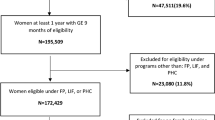Abstract
Objectives: To identify factors associated with awareness of emergency contraception (EC), prior use of EC, and intent to use EC in the future among women at the time of pregnancy testing. Methods: A convenience sample of women presenting for pregnancy testing and being found to be pregnant in 38 primary health care facilities completed a self-administered, anonymous questionnaire. Information regarding demography, pregnancy intentions, use of any contraception, awareness of EC, prior use of EC, and intent to use EC in the future was collected. Results: Of the 583 women that completed the questionnaire, 62% were aware of EC, 4% had previously used EC, and 13% considered using EC in the future. Women aware of EC were more likely to be white, have ≥12 years of education, and report use of birth control prior to the current pregnancy. Younger women, those with <12 years of education, and those not currently living with a partner were more likely to have previously used EC. Women who considered using EC in the future were more likely to be younger, non-white, have <12 years of education, not currently living with a partner, and their usual source of care was a public clinic. Women who considered using EC in the future were also more likely to not want to be pregnant now or ever (21%) compared to women who wanted to be pregnant now or sooner (12%), or with those who were unsure of their current pregnancy (7%). Conclusion: Strategies need to be developed to increase the awareness of EC and determine the factors that would assist in enhancing its utilization.
Similar content being viewed by others
References
Yuzpe AA, Lancee WJ, Ethinylestradiol and dl-norgestrel as a postcoital contraceptive. Fertil Steril 1977;28:932-36.
Delbanco SF, Mauldon J, Smith MD, Little knowledge and limited practice: Emergency contraceptive pills, the public, and the obstetrician-gynecologist. Obstet Gynec 1997;89:1006-11.
van Royen AR, Calvin CK, Lightner CR. Knowledge and attitudes about emergency contraception in a military population. Obstet Gynecol 2000;96(6):921-5.
Cohall AT, Dickerson D, Vaughan R, Cohall R. Inner-city adolescents' awareness of emergency contraception. J Am Med Womens Assoc 1998;53(5 Suppl 2):258-61.
Rosing MA, Archbald CD. The knowledge, acceptability, and use of misoprostol for self-induced medical abortion in an urban US population. J Am Med Womens Assoc 2000;55(3 Suppl):183-5.
Henshaw SK. Unintended pregnancy in the United States. Fam Plann Perspect 1998;30:24-9.
Trussell J, Koenig J, Ellertson C, Stewart F. Preventing unintended pregnancy: the cost-effectiveness of three methods of emergency contraception. Am J Public Health 1997;87(6):932-7.
Trussell J, Duran V, Shochet T, Moore K. Access to emergency contraception. Obstet Gynec 2000;95:267-70.
Ellertson C, Ambardekar S, Hedley A, Coyaji K, Trussell J, Blanchard K. Emergency contraception: Randomized comparison of advance provision and information only. Obstet Gynecol 2001 Oct;98(4):570-5.
Author information
Authors and Affiliations
Corresponding author
Rights and permissions
About this article
Cite this article
Spence, M.R., Elgen, K.K. & Harwell, T.S. Awareness, Prior Use, and Intent to Use Emergency Contraception Among Montana Women at the Time of Pregnancy Testing. Matern Child Health J 7, 197–203 (2003). https://doi.org/10.1023/A:1025140522138
Issue Date:
DOI: https://doi.org/10.1023/A:1025140522138




